Explanation of Men's Dress Shoes, (Hierarchy of Formality and Why Good Dress Shoes Are Expensive,)
Options
Comments
-
bought some semi brogues from payless lmao
Take them back and get you some better shoes mane. If not you better invest in the top of line dr scholls -
bought some semi brogues from payless lmao
Stop playing bruh. If you can spend a $100 on some sneakers or two bills for some J's you can go to Allen Edmonds or Aldens to get some dress shoes that will literally last for 30 years if you take care of them. Also, if you buy the shoes from Allen Edmonds or Aldens you'll be able to have the shoes rebuilt if necessary.https://www.youtube.com/watch?v=1cT5VJmmgVM
Allen Edmonds Shoe Recrafting
-
Maximus Rex wrote: »bought some semi brogues from payless lmao
Stop playing bruh. If you can spend a $100 on some sneakers or two bills for some J's you can go to Allen Edmonds or Aldens to get some dress shoes that will literally last for 30 years if you take care of them. Also, if you buy the shoes from Allen Edmonds or Aldens you'll be able to have the shoes rebuilt if necessary.https://www.youtube.com/watch?v=1cT5VJmmgVM
Allen Edmonds Shoe Recrafting
i aint got that kinda scratch right now
I dont buy Jordans -
Maximus Rex wrote: »bought some semi brogues from payless lmao
Stop playing bruh. If you can spend a $100 on some sneakers or two bills for some J's you can go to Allen Edmonds or Aldens to get some dress shoes that will literally last for 30 years if you take care of them. Also, if you buy the shoes from Allen Edmonds or Aldens you'll be able to have the shoes rebuilt if necessary.https://www.youtube.com/watch?v=1cT5VJmmgVM
Allen Edmonds Shoe Recrafting
i aint got that kinda scratch right now
I dont buy Jordans
Save your money then. You'll be glad that you did. -
Maximus Rex wrote: »Maximus Rex wrote: »bought some semi brogues from payless lmao
Stop playing bruh. If you can spend a $100 on some sneakers or two bills for some J's you can go to Allen Edmonds or Aldens to get some dress shoes that will literally last for 30 years if you take care of them. Also, if you buy the shoes from Allen Edmonds or Aldens you'll be able to have the shoes rebuilt if necessary.https://www.youtube.com/watch?v=1cT5VJmmgVM
Allen Edmonds Shoe Recrafting
i aint got that kinda scratch right now
I dont buy Jordans
Save your money then. You'll be glad that you did.
I took them back and caught a pair of cole haans and a pair of steve maddens on sale this weekend, ? they was barely more than the payless shoes -
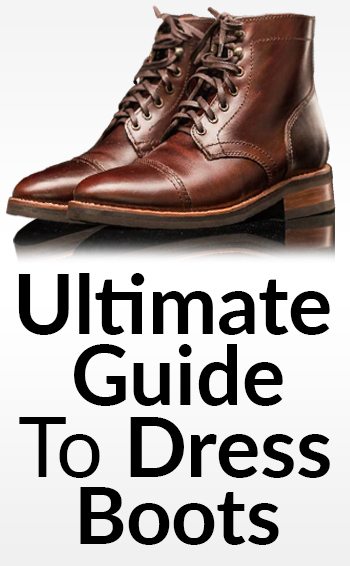
http://www.realmenrealstyle.com/guide-dress-boots/
Versatility. Masculinity. Durability. What ONE shoe embodies all these words? The answer? It’s not a shoe……It’s the dress boot. Are dress boots really necessary? Do you need to buy a pair to round out your wardrobe? Well out of the 30 pairs of shoes in my closet….I wear my dress boots 50% of the time. Yeah – they’re just that useful! They send the message I want to say (rugged, stylish, strong)…and when I’m walking up wet bleachers (like at my son’s football game!) I don’t fall on my backside! Dress Boots RULE! This article is going to be your ultimate guide to the dress boot.https://www.youtube.com/watch?v=0aESzO5EIHY
This post was brought to you in collaboration with Thursday Boots. I’ve been field testing this company for over 6 months. When it comes to comfortable dress boots they win. Why? Because they have a buttery soft inner glove lining, an EVA comfort strip, and a cork bed midsole that molds to the foot. In other words, 14 hours after wearing them they will still feel GREAT.
1. Why Wear Dress Boots?
First let us agree on how to distinguish a boot from a shoe: A dress boot is simply a dress shoe with ankle support.
1A: Historical Relevance
Boots and boot fashion are rooted in a long history. The very first boot that existed was a lashed combination of three separate pieces: the sole, upper and leggings. It went through a lot of transformations.
Ancient Times
Early versions of the boot were worn by kings and emperors while most of the population went barefoot. They were embroidered with colorful jewels and had gold soles. The type known as campagnus was worn by senators and high-ranking officers in ancient Rome – the height of the boot denoted their rank.
Middle Ages
Recordings show that courtiers of the Carolingian period wore long boots that were laced halfway up the leg.
15th Century
Men would wear thigh-length boots that were normally made of brown leather. This was the common style among those in the working class.
17th Century
The first military uniforms were created and along came a more polished boot with a rigid leg – the prototypical jackboot. It was practical footwear for army men and protected the legs well while riding a horse. The style served as inspiration for the “jockey” boot that soon followed. This one was softer and had the top folded down under the knee for mobility. Men who weren’t in battle got to use it for riding sports.
Late 18th Century
Several other boots that were named after military figures or developments started to become trends: Blucher, Hessian and Wellington.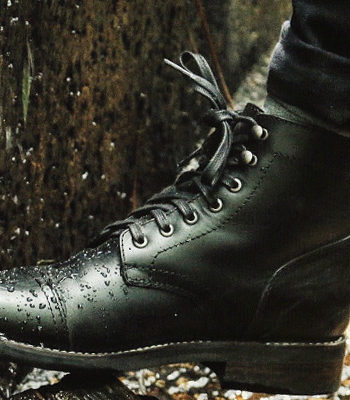
1B: Power And Prestige
What’s shown in the past is boots have symbolized ruling power and strength. Earlier on they were only for people of high authority like in Ancient Rome – where leather was expensive back then. But what leaders wore were eventually passed on to the common folk.
Ordinary men liked wearing boots throughout history. At some points they even preferred them to shoes. It was the 14th and 15th centuries when shoes were first made with leather, cloth or silk – and were normally flat. They weren’t as prestigious as boots.
Only in the early 1600s did shoes (paired with stockings) reach their peak. James I of England was ruling and court fashions were flamboyant and decorative. Wealthy people had their shoes fixed with rosettes or bows. The trend didn’t last long once Charles I took over. Wars and political instability forced things to change and people soon switched to military-inspired boots. It was a more serious time.
1C: Protection
From a practical standpoint, boots take better care of your feet and lower legs than shoes do. They’re meant to give you extra protection from bad weather or environmental hazards. This is why many designers nowadays think of boots as fall/winter accessories.
1D: Versatile Style
Wear boots and you can change up your style. You look outdoorsy – like you’re ready to go horseback riding or chop some wood. Society puts emphasis on a healthy and active lifestyle. People who get out there and break a sweat (even if it’s cold) seem more attractive these days. Boots offer that kind of style.
1E: The Message Dress Boots Send
Boots set us up for certain perceptions that are either true or sort of true. But you’ll want them to apply regardless.
Masculinity: You appear big and manly. That’s because they cover more of the legs and look heavier than shoes. Some also have larger heels. And let’s not forget that dress boots aren’t as “refined” as dress shoes. Some women like the more rugged look.
Social status: You can afford to cover up for the cold months.
Responsibility: You know how to take care of yourself.
Respect: You’re worth some degree of respect since you look “important” – we trace it back to boots’ history as military footwear.
Character: You wear your chosen boots your way and not let them wear you.
Taste: You show that you bought those boots with discretion (given they look awesome on you) and not just out of need.
Individuality: You’re presenting yourself with whatever presents YOU – your true self – best.
2. Dress Boot Anatomy
Let’s now get a better understanding of the boot in terms of composition. Most of these parts reflect the type of boot or lacing system that applies to any given pair.
2A: The Upper
Here we have all of the components found above the sole. These are the parts that affect design, appearance and circulation (allowing air to enter and keep feet at a constant temperature).
Quarter: covers the back and sides of the boot. It’s wrapped around the heel and connects to the vamp.
Lining: adds more durability and protection. It can be made of leather, fabric or synthetics. The lining on the insole is called “the sock.”
Tongue: the flap going underneath the laces to cover the throat. It prevents dirt and water from entering the boots.
Open Lacing: where the bootlaces are found.
Throat: the central part formed by the seam that joins together the vamp and the quarter.
Eyelets: the small round holes (often fixed with metal rings) through which the laces are tied.
Vamp: the front area that protects the instep.
Toe: the flattish portion that extends from the vamp. It fully covers the toes up to the tip where it joins with the sole.
Welt: the border of the boot. It’s made of a material (i.e. leather) that is sewn along the edge of the upper.
2B: The Sole And Below
The following are the parts that support the bottom of your foot and provide balance and comfort.
Insole: the base for the foot that anchors together all parts of the upper.
Outsole: the durable outer sole of the boot. Ideally it’s waterproof and resistant to slips or skids.
Heel: the raised component that’s found underneath the back of the sole. It lessens the impact of the ground on the heel of your foot.
Shank: made of metal or plastic plates that are built into the sole. It reinforces stability and prevents the boot from distortions while it’s worn. Boots with wedged soles or low heels don’t need a shank. -
Ultimate Guide to Dress Boot Pt. II
3. Types of Dress Boots
There are three major categories of dress boots every guy should be aware of: Chukka boots, Chelsea boots, and lace-up boots. We’re breaking down each type in terms of style and lacing, as well as the advantages to wearing each one.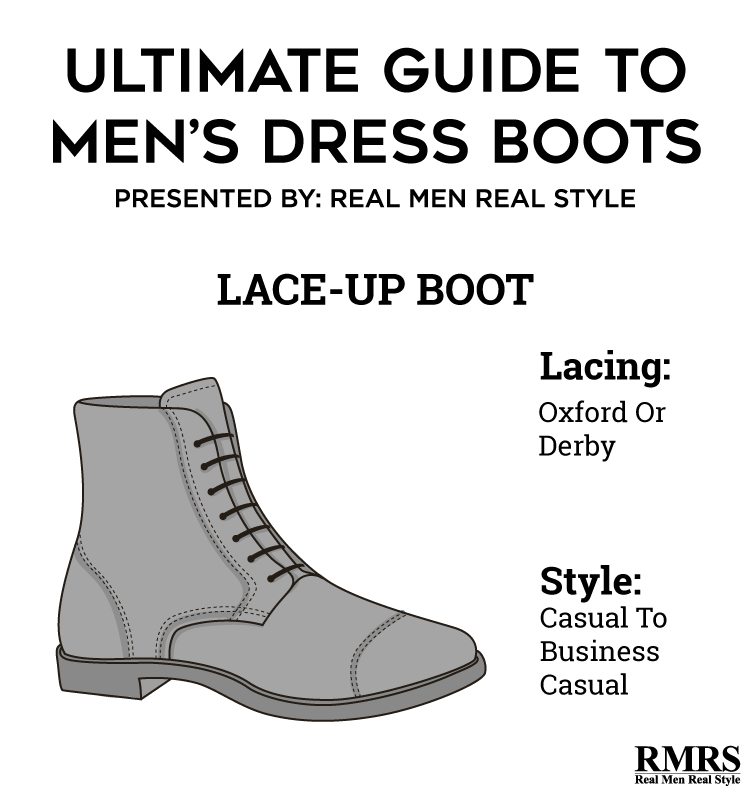
3A: Lace-Up Boot
The lace-up boot is pretty much an ankle-high version of the dress shoe. History shows the first of its kind was worn by Prince Albert, who asked for something he could wear on the grouse fields of his Scottish estate and that also looked stylish indoors. The boot is a great alternative to Oxford or Balmoral shoes – they share similar degrees of classiness.
Lacing
Both Oxford and Derby systems are suitable for lace-up boots. Whether one works better than the other depends on the boot design and purpose.
Style
In general these boots function as casual/business casual wear. However you can make an exception for black ones in professional occasions. Formal footwear is traditionally made of patent leather but a pair of sleek black lace-up boots is now acceptable.
Advantages
Since lace-up boots are similar to dress shoes, they share a simple aesthetic that’s easy to pair with a good suit. They are smart and timeless classics (especially the closed-laced ones). These boots add more class to even those tired or unoriginal outfits. That is why they’re reliable all-around.
3B: Chelsea Boot
The Chelsea boot goes all the way back to the Victorian era when men and women first wore it. Queen Victoria herself was known to walk in a pair every day. The ‘60s saw the boot become iconic all over the UK (as well as internationally) when The Beatles commissioned a special version with pointed toes and Cuban heels.
Lacing
These ankle-high boots are laceless. You slip them on and get them off just as easily by pulling the loop of fabric at the back.
Style
Chelsea boots work in both formal and casual situations. It doesn’t matter if it’s a suit or a blazer, whether your pants are dress slacks or designer jeans. These boots are great to wear most of the time. The key is picking the right color – black, brown, oxblood etc.
Advantages
These lace-free boots have elastic panels on either side of the quarter (part of their signature style). The panels keep them close-fitting and breathable inside. So for those who enjoy walking and horseback riding – Chelsea boots give them equal degrees of tightness and comfort.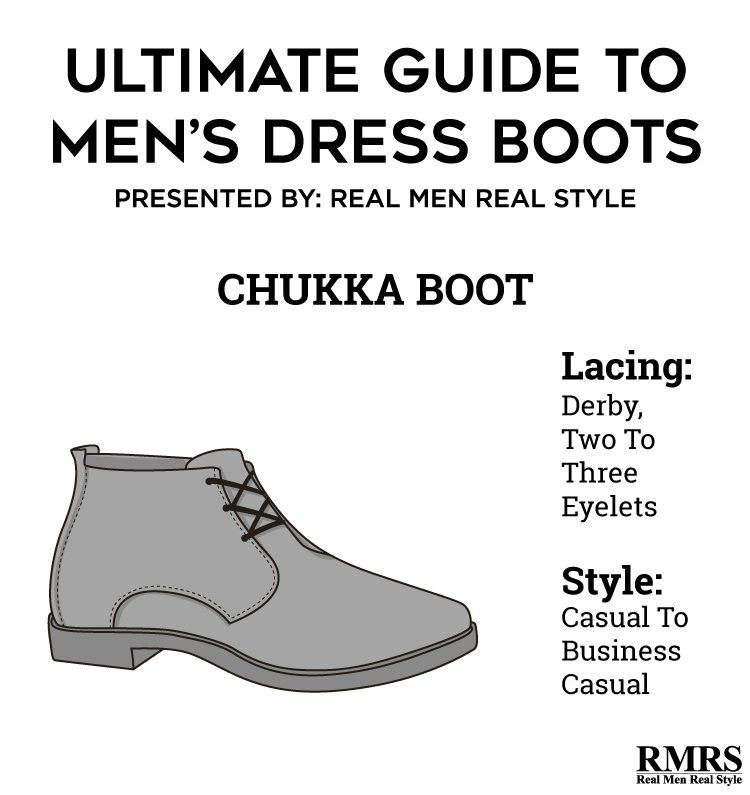
3C: Chukka Boot
Many believe the Chukka boot originated in India among British soldiers who enjoyed playing polo. It was in 1924 when it reached US soil courtesy of the Duke of Windsor (who had also played polo and traveled to India). The name is a modification of “chukker” – the period of play in polo matches. Chukkas broke out in the late ‘40s, and until now they’re popular choices for casual and sporty wear.
Lacing
A Chukka boot has three pairs of eyelets and its laces are tied using the Derby system. They’re designed to look and feel comfortable.
Style
The rough-looking leather used to make chukkas is what gives them a strong casual appeal. The upper is made with suede or calfskin while the sole is leather-based. Both sections are traditionally made with contrasting colors.
Advantages
Unlike other boots chukkas feel light and loose when walking around in them. There’s enough foot protection through their leather-based uppers and sturdy outsoles.
Another advantage is their flexibility as footwear. They’re great with relaxed outfits such as a t-shirt and nice jeans. If you want something dressier like a sports jacket and slacks, these boots will work just as fine. That dressing up/dressing down convenience is why many young men enjoy wearing chukkas.
3D: Desert Boot
Desert boots are the most popular version of the Chukka today. They were first designed as comfortable and practical footwear for the British Army during World War II. Soldiers would use them for downtime while they were in the desert. These boots also use Derby lacing and share the same advantages as any chukka boot.
But desert boots have a slightly different style. They have either 2 or 3 pairs of eyelets and a sole made of crepe (a strong rubber) instead of leather. Another thing about them is the stitching around the sole – which isn’t as visible on other chukkas. This is what makes them look more casual. -
Ultimate Guide to Dress Boots, fin.
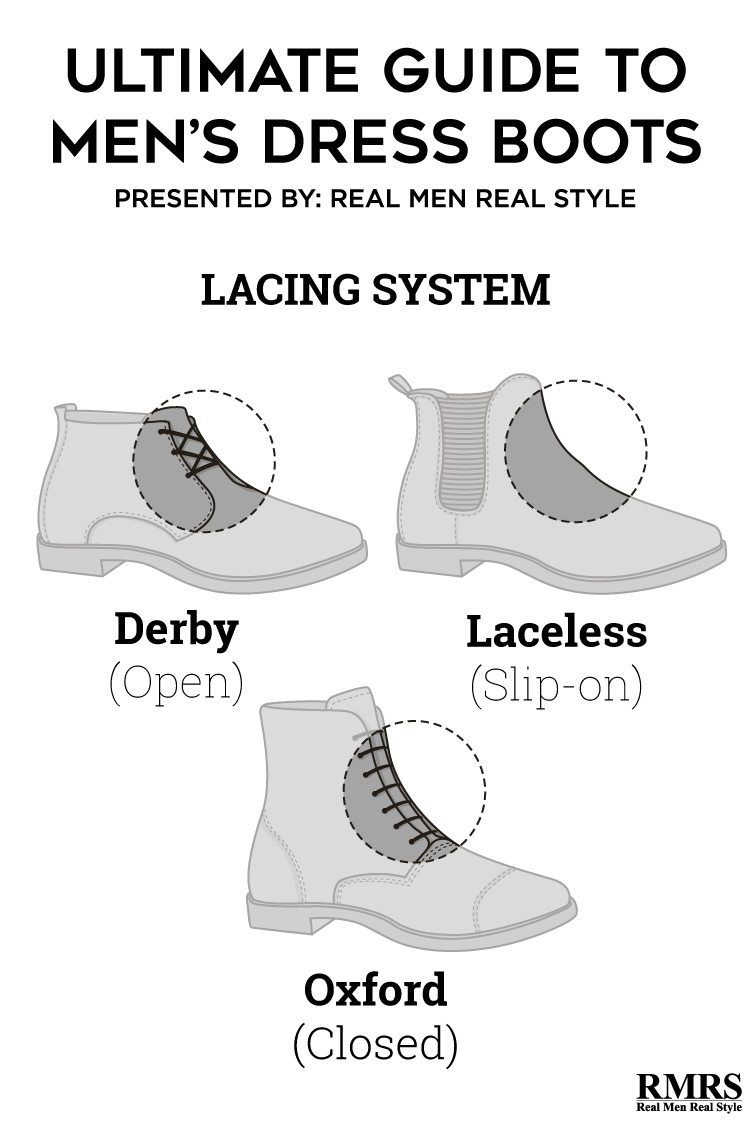
4. Lacing Systems
4A: Derby (Open)
Derby or open-laced refers to boots that have eyelets sewn on top of the vamp. It’s also called “crisscross lacing” and works well for chukkas and less formal boots. The lacing can be made looser or tighter depending on your preference.
Purpose
Derby lacing started in the mid-19th century on boots and shoes that were used for hunting and sport. Only in the 20th century did more men start wearing them in the city. People soon found open-laced footwear more comfortable than closed-laced because of the expandable upper. Men these days still enjoy Derbies for relaxed casual attire.
4B: Oxford (Closed)
Meanwhile Oxford lacing has eyelets stitched under the vamp instead of above it. The vamp itself is sewn on top of the quarters while the tongue is an underlying part of it. The proper technique to lace Oxford boots is horizontally and parallel. The final look – neat horizontal lines – can be achieved in multiple ways but some aren’t as easy as others to tighten.
Purpose
These boots give significantly less upper allowance than open-laced boots. It’s that tight and neat lacing that makes them more formal choices. They are great for black-tie events and situations where you want to showcase your best self.
4C: Laceless (Slip-On)
The name says it all: no laces or tying up. The current popularity of slip-on boots (particularly with Chelsea boots) proves that unconventional-looking footwear can be stylish.
Purpose
Convenience is the number-one plus point with laceless boots. Because of flexible panels and loops at the back these boots are easy to wear and take off. Black versions go really well with suits and business attires.
5. Toe Types
Plain Toe
Toes on these boots are devoid of any lines. The toe and vamp have been “merged” to make everything look clean and minimalistic. That translates to extremely plain for some people.
Cap Toe
Cap toes are by far the most traditional type. Only the edge is patterned (normally with brogue) and this keeps the boots sleek and classy. They’re the most preferred design for business settings. But granted they might look boring when frequently worn in and out of the office.
Wingtip Toe
This edgier version of the cap toe has a pattern that spreads from the center point towards the sides. These wing-like details make the boots less chic but more interesting. Wingtip toes are perfect for casual wear.
Wingtip Medallion
The most decorative type, it’s a more complex version of the wingtip toe. Stitching or broguing is done all over the toe’s surface. The busy-looking patterns of wingtip medallions make them far more casual (and showy) than the rest.
An Additional Reminder
Remember that proportions matter when it comes to boots. It’s crucial to always take the boot’s shape into account whenever you buy trousers with a certain fit – and vice-versa.
The trick to managing boot proportions is to wear either straight leg or slim fit jeans. This accentuates the boots’ shape and style.
Always make sure your pants aren’t covering the boots beyond an inch or two. You don’t want them looking like another pair of shoes! Use cuffings or have the pants altered if necessary.
Keep all this information in mind. Stick to what we know about boots and soon you’ll find a pair that best expresses your character, your taste and individuality. Let boots give you a boost in style! -
Maximus Rex wrote: »Maximus Rex wrote: »bought some semi brogues from payless lmao
Stop playing bruh. If you can spend a $100 on some sneakers or two bills for some J's you can go to Allen Edmonds or Aldens to get some dress shoes that will literally last for 30 years if you take care of them. Also, if you buy the shoes from Allen Edmonds or Aldens you'll be able to have the shoes rebuilt if necessary.https://www.youtube.com/watch?v=1cT5VJmmgVM
Allen Edmonds Shoe Recrafting
i aint got that kinda scratch right now
I dont buy Jordans
Save your money then. You'll be glad that you did.
I took them back and caught a pair of cole haans and a pair of steve maddens on sale this weekend, ? they was barely more than the payless shoes
Hit up a DSW homie


